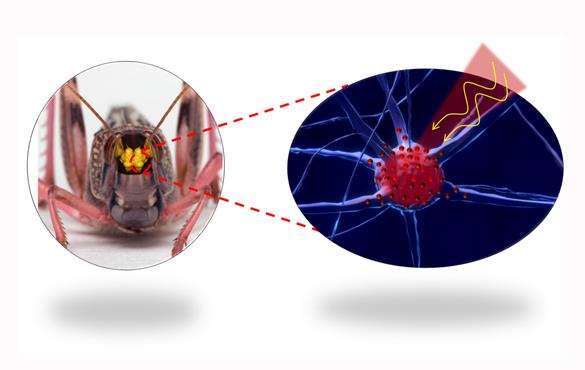Light-activated nanoheaters may control nerve cells, locust mind
Srikanth Singamaneni and Barani Raman will team up to develop an innovative toolkit that they anticipate will provide control of neural activity in the brain

The neurons in our brains are its basic computational units analogous to a computer transistor. They process information and send and receive messages to and from the rest of our bodies. Engineers at Washington University in St. Louis want to know if they can control certain neurons using nanotechnology to better understand behavior and disease.
Srikanth Singamaneni, professor of mechanical engineering & materials science, and Barani Raman, associate professor of biomedical engineering, both in the McKelvey School of Engineering, will combine their expertise in nanotechnology and neuroscience to develop an innovative toolkit that they anticipate will provide control of neural activity in the brain. They have received a four-year, $678,000 grant from the Air Force Office of Scientific Research to conduct the research.
Initial work was funded by a seed grant from the university's McDonnell Center for Systems Neuroscience in 2015 and from a Collaboration Initiation Grant from the McKelvey School of Engineering in 2016.
Using plasmonic nanostructures modified with specific biomolecules, frequent collaborators Singamaneni and Raman plan to harness the "photothermal effect," the conversion of light to heat, to control the neural activity in animal and insect models.
In essence, the team will create heating elements on the nanoscale to efficiently convert light at specific wavelengths into heat. This effect is both rapid and local ensuring minimal damage to the tissue in which the nanoheaters will be embedded. The team will target certain neurons using antibodies specific to the receptors on the surface of neurons. Such a technique is unique in the field.
"We use gold nanostructures because we can tune the plasmon resonance to the visible and near-infrared parts of the electromagnetic spectrum," said Singamaneni, a materials scientist. "When you shine these particular wavelengths of light, the nanostructures adsorb and convert that light into heat. Because the nanostructures are specifically targeted to certain cells, or neurons, the heat will be localized to these neurons."
"Antibodies have been used in gold nanoparticles to capture the protein biomarkers and to detect those proteins in biological fluids," Singamaneni said. "We are going to use the same kind of conjugation chemistries to attach these antibodies to the nanoparticles, but in this case, the nanoparticles themselves are going to latch on to specific neurons."
In addition to nanoparticles in solution, the team will use the plasmonic patch — a highly flexible polymer film studded with plasmonic nanoparticles — which serves as a transparent blanket to conformally cover the neurons cultured on solid substrates and in a locust brain to control their locomotion and behavior.
Raman, a biomedical engineer, said using a simple model such as the locust brain is a good starting place to fine-tune such a technology before progressing onto more complex animal models.
"FDA-approved treatments for Parkinson's disease, such as deep-brain stimulation, are still very coarse," Raman said. "There is a great need for approaches that can be refined to target certain subpopulations or a certain area of the brain."
Singamaneni and Raman have collaborated on multiple projects leading up to this research, including a study integrating optical and electrical sensing modalities and another studying the olfactory system of locusts, both funded by the Office of Naval Research.





